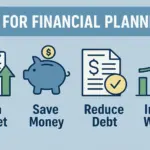When it comes to investing, one of the smartest moves you can make is using a portfolio diversification strategy. It might sound like a big phrase, but it’s actually a simple idea: don’t put all your eggs in one basket. Instead, spread your money across different investments to lower the risk of losing it all.
What Is a Portfolio Diversification Strategy?
A portfolio diversification strategy means putting your money into different types of investments rather than just one. For example, instead of only buying stocks from one company or one industry, you might invest in a mix of:
-
Stocks from different industries
-
Bonds
-
Mutual funds
-
Real estate
-
International markets
-
ETFs (Exchange Traded Funds)
By doing this, you’re reducing the chances that one bad investment will ruin your entire financial plan. If one part of your portfolio goes down, other parts might go up or stay stable, helping balance your overall performance.
Read More: dgmnews.com
Why Is Diversification So Important?
The world of investing is full of ups and downs. Markets go up, but they also go down—sometimes suddenly. A portfolio diversification strategy helps you handle these changes better. Here are a few key reasons why it’s so important:
-
Reduces Risk: If one investment fails, the others can help you stay afloat.
-
Smoother Growth: It helps your money grow more steadily over time.
-
Protects Against Market Shocks: You’re less likely to be hit hard by sudden changes.
-
More Opportunities: Different investments grow in different ways. Diversifying helps you tap into more than one type of growth.
Different Types of Diversification
Let’s break down the different ways you can diversify your portfolio:
1. Asset Class Diversification
This means spreading your money across various asset types. These include:
-
Equities (stocks)
-
Fixed income (bonds)
-
Cash or cash equivalents
-
Commodities (like gold or oil)
-
Real estate
Each of these behaves differently. For example, stocks can grow fast but are riskier, while bonds are more stable but grow slowly.
2. Industry Diversification
Don’t just buy tech stocks or only invest in real estate. Use your portfolio diversification strategy to include industries like:
-
Technology
-
Healthcare
-
Energy
-
Consumer goods
-
Financial services
If one industry suffers, others might thrive.
3. Geographical Diversification
It’s also smart to invest in other parts of the world. The U.S. market might be struggling while Asia or Europe is booming. Including international funds or stocks from other countries can help balance your portfolio.
4. Company Size Diversification
Big companies (like Apple or Google) are more stable. But small or mid-sized companies often grow faster. Having a mix of large-cap, mid-cap, and small-cap stocks helps your portfolio stay balanced and growth-friendly.
How to Start Building a Diversified Portfolio
You don’t need to be a financial expert to build a solid portfolio diversification strategy. Here’s how to get started:
Step 1: Know Your Risk Tolerance
Ask yourself: How much risk am I okay with? If you’re younger, you might be able to handle more risk because you have time to recover. If you’re closer to retirement, you’ll want safer choices.
Step 2: Choose a Mix of Assets
Based on your risk level, pick different types of investments. For example:
-
High risk: More stocks, fewer bonds
-
Medium risk: Balanced mix of stocks and bonds
-
Low risk: More bonds, fewer stocks
Step 3: Use Index Funds or ETFs
These are great tools for diversification. One index fund can give you exposure to hundreds of companies at once.
Step 4: Rebalance Regularly
Every few months or once a year, check your portfolio. If one investment has grown a lot, it might take up too much space in your portfolio. Rebalancing means adjusting your mix back to your original plan.
Common Mistakes to Avoid
Even with a good portfolio diversification strategy, some mistakes can hurt your results. Watch out for these:
-
Over-Diversification: Spreading too thin can make it hard to see real growth.
-
Ignoring Fees: Some funds charge high fees. Look for low-cost index funds or ETFs.
-
Not Rebalancing: If your mix gets out of balance, your risk level might be higher than you think.
-
Following Trends Blindly: Just because everyone is buying something doesn’t mean you should too. Stick to your strategy.
Real-Life Example
Let’s say Alex has $10,000 to invest. Instead of putting it all in tech stocks, Alex creates a portfolio diversification strategy like this:
-
$3,000 in U.S. stocks
-
$2,000 in international stocks
-
$2,000 in bonds
-
$1,500 in real estate fund (REIT)
-
$1,000 in a commodity ETF (like gold)
-
$500 in cash or savings
If tech stocks drop, Alex’s whole portfolio won’t be badly hurt because other areas may stay steady or even grow.
Benefits Over Time
A good portfolio diversification strategy helps you:
-
Sleep better at night (less worry about crashes)
-
Enjoy long-term growth
-
Handle market ups and downs calmly
-
Achieve your financial goals with less risk
It’s not about getting rich quick—it’s about growing your wealth steadily and safely.
How Technology Helps
Today, apps and tools make it easier than ever to manage a diversified portfolio. Robo-advisors can even build one for you based on your goals and risk tolerance. You just need to set your preferences and let them do the work.
Final Thoughts
A well-planned portfolio diversification strategy is like a safety net for your money. It helps you grow wealth while protecting you from big losses. Whether you’re just starting or already investing, diversification is a strategy you shouldn’t ignore. Keep it simple, stay consistent, and review your choices from time to time.
Remember: No one can predict the future, but you can prepare for it.
FAQs
1. What is the main goal of a portfolio diversification strategy?
The main goal is to reduce investment risk by spreading your money across different assets, industries, or regions. This way, if one investment performs poorly, others can balance it out.
2. Can I use this strategy with a small amount of money?
Yes! You don’t need thousands of dollars. Many mutual funds and ETFs allow you to invest with as little as $50 or $100, giving you access to multiple investments in one go.
3. How often should I update or rebalance my portfolio?
Most experts suggest rebalancing once or twice a year. Check if any part of your portfolio has grown too large or too small, and adjust to keep your original plan in balance
Read More: sbi equity hybrid fund


